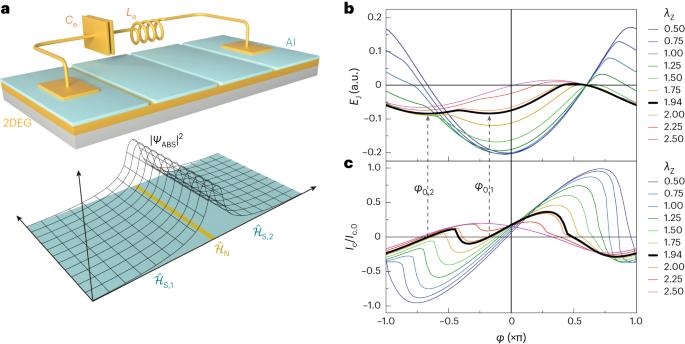超电流二极管中约瑟夫森电感磁手性各向异性的符号反转和0 π样跃迁。
IF 38.1
1区 材料科学
Q1 MATERIALS SCIENCE, MULTIDISCIPLINARY
引用次数: 9
摘要
最近发现的固有超电流二极管效应,以及它在各种系统中的迅速观察表明,当空间反转和时间反转对称性被打破时,非互易超电流自然出现。在Josephson结中,非倒易超电流可以方便地用自旋分裂的Andreev态来描述。在这里,我们证明了约瑟夫森电感的磁手性各向异性的符号反转,这是超导二极管效应的一种表现。约瑟夫森电感作为超电流函数的不对称性使我们能够探测接近平衡的电流相关系,并探测结基态的跳变。利用最小理论模型,我们可以将电感磁手性各向异性的符号反转与所谓的0 π样跃迁联系起来,这是多通道结的一个预测但仍然难以捉摸的特征。我们的结果证明了电感测量作为非常规约瑟夫森结基本特性的敏感探针的潜力。本文章由计算机程序翻译,如有差异,请以英文原文为准。

Sign reversal of the Josephson inductance magnetochiral anisotropy and 0–π-like transitions in supercurrent diodes
The recent discovery of the intrinsic supercurrent diode effect, and its prompt observation in a rich variety of systems, has shown that non-reciprocal supercurrents naturally emerge when both space-inversion and time-inversion symmetries are broken. In Josephson junctions, non-reciprocal supercurrent can be conveniently described in terms of spin-split Andreev states. Here we demonstrate a sign reversal of the Josephson inductance magnetochiral anisotropy, a manifestation of the supercurrent diode effect. The asymmetry of the Josephson inductance as a function of the supercurrent allows us to probe the current–phase relation near equilibrium, and to probe jumps in the junction ground state. Using a minimal theoretical model, we can then link the sign reversal of the inductance magnetochiral anisotropy to the so-called 0−π-like transition, a predicted but still elusive feature of multichannel junctions. Our results demonstrate the potential of inductance measurements as sensitive probes of the fundamental properties of unconventional Josephson junctions. A sudden inversion of the supercurrent diode effect is revealed in both inductance and critical current measurements in ballistic Josephson junctions. A simple analytical model shows that the inversion is associated with a ground state jump, the elusive 0−π-like transition.
求助全文
通过发布文献求助,成功后即可免费获取论文全文。
去求助
来源期刊

Nature nanotechnology
工程技术-材料科学:综合
CiteScore
59.70
自引率
0.80%
发文量
196
审稿时长
4-8 weeks
期刊介绍:
Nature Nanotechnology is a prestigious journal that publishes high-quality papers in various areas of nanoscience and nanotechnology. The journal focuses on the design, characterization, and production of structures, devices, and systems that manipulate and control materials at atomic, molecular, and macromolecular scales. It encompasses both bottom-up and top-down approaches, as well as their combinations.
Furthermore, Nature Nanotechnology fosters the exchange of ideas among researchers from diverse disciplines such as chemistry, physics, material science, biomedical research, engineering, and more. It promotes collaboration at the forefront of this multidisciplinary field. The journal covers a wide range of topics, from fundamental research in physics, chemistry, and biology, including computational work and simulations, to the development of innovative devices and technologies for various industrial sectors such as information technology, medicine, manufacturing, high-performance materials, energy, and environmental technologies. It includes coverage of organic, inorganic, and hybrid materials.
 求助内容:
求助内容: 应助结果提醒方式:
应助结果提醒方式:


